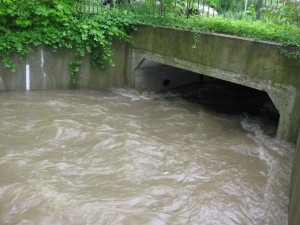Following is a day in the life of our Water Quality Intern, Jon Doubek. Each season our interns immerse themselves in the river and creeks to help us determine water quality status and trends.

It is a partly sunny morning, with hints of overcast and storm in the distant west. Volunteers arrive at the HRWC offices ready for an exciting day of water sample collections and flow measurements. I prepared all the equipment for a sampling quest; the supplies are collected and deposited into the trunk and backseat of my little, white Honda Civic. Everyone exchanges their pleasantries as they discuss the sampling plans for the day. “Today we will collect our usual water samples for water quality analyzes, but we will also record a flow measurement since we do not yet have a low flow for the creek this season,” I tell the volunteers, keeping in mind that the bottles will need to be submitted to the laboratory before the impending storm.
Everyone arrives at the creek and three nutrient samples are collected for laboratory analyzes: one for total phosphorus, one for nitrate-nitrite and total suspended sediments, and one for E. coli. These parameters are indicators of overall water quality, and point us to local problems that might be contributing to elevated levels of one or more of these compounds. Next, we use a Horiba — a monitoring instrument used for non-nutrient parameters. The volunteers record the pH (or acidity/basicity of the water), conductance (electrical charge in the water, often a result of salts and metal ions), temperature, and dissolved oxygen. Finally, we measure flow. Since flow is a combination of surface area, depth, and velocity, a transect of water is chosen at the sampling site that is ideal for a flow measurement. We use another instrument to record the velocity of water at equidistant points across the creek. We repeat this about 15 times across the chosen transect to generate an accurate profile of the flow at that particular point in time.
After repeating this at other sampling sites, the volunteers and I arrive at the Ann Arbor Water Treatment Plant lab to drop off the samples for chemical analyses, before returning back to the HRWC offices. Everyone parts ways pleased to know it has been a successful and fun sampling session. As I prepare the sample bottles and equipment for the afternoon sampling session, rain begins to pellet the windows outside. Ric Lawson, the Program Manager, makes the call to set up the autosampler for a storm event. But, that is a story for another day. We did some good scientific work that will provide information HRWC can use to evaluate progress and plan future projects.



